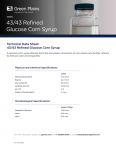Romer Labs offers alternative to costly acetonitrile for mycotoxin analysis
The solvent acetonitrile is widely used by laboratories in HPLC (chromatographic testing) methods for the extraction of samples, such as ground cereals or grains.
But recent world events have conspired to push the cost of acetonitrile up to levels three-fold their market prices last year.
A pure grade 2.5 litre of acetonitrile today costs about €100, shooting up from approximately a third of this price in early 2008.
"A lot of work was behind the change in process, and we now offer methods that use methanol, not acetonitrile," a spokesperson the diagnostic firm Romer Labs told BakeryandSnacks.com.
Supplies of acetonitrile began to slow down in autumn last year when the Chinese government, mindful of air-quality during the Olympics, attenuated production of acetonitrile.
Impacting suppliers further, an acetonitrile refining facility in Texas, US saw output cut short by damage caused by Hurricane Ike.
Added to these reasons is the slowdown in the global economy. Acetonitrile delivered to the market also comes as a by-product of acrylonitrile production, derived from the manufacture of plastic components widely used in the car industry. And an industry considerably impacted by the economic downturn.
With an eye on dwindling supplies, Romer Labs evolved their methanol-based HPLC method as an alternative for laboratories.
Before a sample of the ground cereal or grain was mixed with acetonitrile, shaken and filtered through the clean-up colium, explains the Romer Labs spokesperson. This filtrate would then be ready for HPLC analysis.
Switching to a different solvent, methanol, involved Romer Labs running a series of experiments to ensure that the clean-up colium "worked well" with the new solvent.
Comparing the switch in solvent to a recipe, the spokesperson added: "You change an ingredient , and you usually have to adapt the entire recipe".
Due to sourcing difficulties and high costs for acrylonitrile, Romer Labs claims "many of our customers are now using this methanol method".













